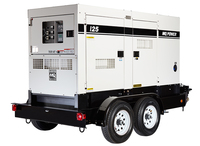Temporary Power Options After a Natural Disaster
In January of 2016, one million people living in states between Arkansas to Massachusetts were drastically impacted by a fierce winter storm. This storm was so severe that over 500,000 individuals lost power in the Carolinas alone. Losing the ability to perform routine activities was debilitating for the families and businesses affected, and losing heat was downright dangerous. Power is one of the the main components to modern survival. They provide us with endless opportunities such as staying warm, cooking, and even remaining up to date with weather alerts. When natural disasters strike, it is vital to be prepared for all possible scenarios. Let’s consider temporary power options that can prove to be a saving grace in the midst of chaos.
Generators
Generators are excellent investment options for providing power. These handy appliances turn gasoline, propane, and other forms of mechanical energy into electricity.
What’s awesome about owning a personal generator, is that this appliance can provide power to an entire household when disaster strikes. Because of their longevity, generators can run between $850 and well into the thousands, but they are also available to rent for short-term use. The two different types of generators for the home are portable and standby. Portable generators require gas fuel and a power output. They can provide power as needed, and are low on the spectrum of cost. Standby generators are heavy duty options that use natural and propane gas to generate energy. Although quite costly, standby generators are well worth the investment. As opposed to the start-up work associated with the portable option, standby generators begin working as soon as a power outage is detected.
Home Battery Backup Systems
Battery backup systems are quiet, exhaust free power options that work to convert small volume, DC voltages into higher, AC voltages that generate power. This system works with a built-in inverter that handles all voltage conversion and instant connection. Some work in conjunction with a portable generator to recharge the system if being used for a long period of time. Modern versions of this system use solar panels to recharge the batteries when needed.
Spot Chargers
Sport chargers allow users the opportunity to charge cell phones, flashlights, and other small electrical devices. These chargers operate under two systems: solar and crank powered. The issue with solar chargers is that they require dry and bright areas to work. They may prove to be a bit of a challenge during a hurricane or ice storm. Smaller charges known as “juice packs” can fit directly on your cell phone and keep your battery charged for an extended period of time. Power inverters work for larger devices and they come in a variety of voltage options.
There are several cost effective ways to providing energy to your household or business during critical times. The key is to determine the type of energy you are in need of so as to choose the right energy providing system for your home. By doing so, you will be able to have your essential needs taken care of during natural disasters.

